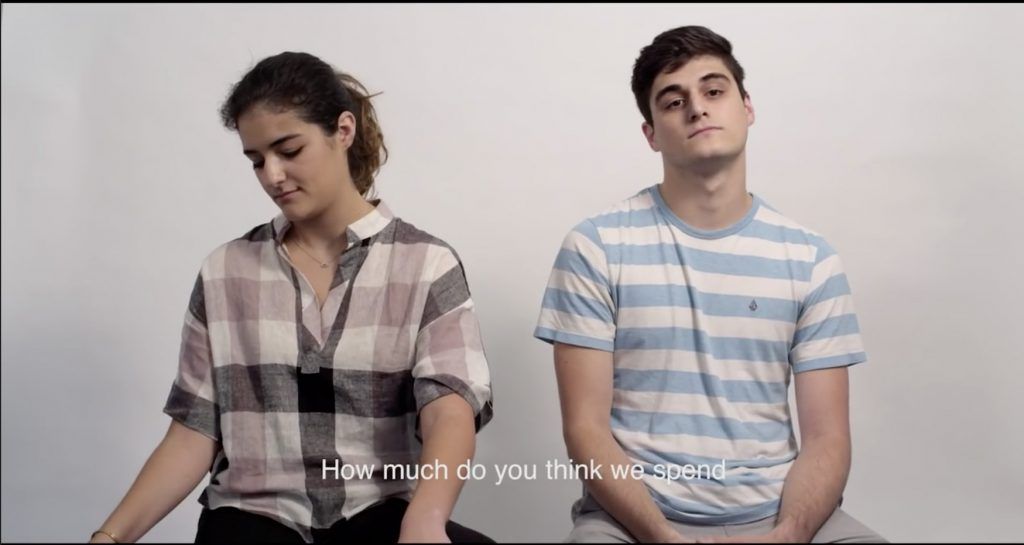Reducing the risk of nuclear war begins in the classroom
By Luisa Kenausis, Aron Bernstein , Robert P. Redwine, Michael Hynes | September 21, 2018
 When asked how much they think the US spends each year on its nuclear arsenal, most college students had no idea. Image courtesy Jonathan Deaton, Nukebusters Short Film Contest.
When asked how much they think the US spends each year on its nuclear arsenal, most college students had no idea. Image courtesy Jonathan Deaton, Nukebusters Short Film Contest.
As long as nuclear weapons exist, they will continue to pose a severe threat to the planet and its inhabitants. Whatever helpful role nuclear weapons may have played in deterring great power conflict since World War II, it is difficult to imagine that their benefits are worth the perpetual risk of their use. Any international use of a nuclear weapon—intentional or not, authorized or not—could escalate to a devastating war with unthinkable consequences. A large-scale nuclear exchange would lead to nuclear winter, which would undoubtedly cause horrific mass starvation and could feasibly cause the extinction of the human race. If this danger is ever to be alleviated, policymakers around the world must continue to seek progress on nuclear disarmament.
The obstacles to nuclear disarmament are significant. There is a conflict between the security interests of states possessing nuclear weapons, which rely on nuclear deterrence to assure their defense, and the security interests of the world’s population as a whole—which is arguably made less safe overall by the existence of nuclear weapons and the associated risk of nuclear war. Resolving this conflict and creating conditions that allow states to disarm without compromising their security interests is certainly a tall order. But it should not be dismissed as impossible. Instead, emphasis should be placed on developing longer-term approaches that can help to bring about the conditions for disarmament at some point in the future. Efforts should not be restricted to political or strategic thinking on this question. Instead, policy makers should step back and ask themselves: How can we prevent the next generation of leaders from falling into the same paralysis on nuclear disarmament? What can we do today to encourage new and innovative thinking on the political and security challenges of nuclear weapons, five or 10 years down the line?
Our suggestion: Turn to the classroom.
This idea is not a new one. In 2002, the United Nations performed a landmark study on disarmament and nonproliferation education. Sixteen years later, the words of then-Secretary-General Kofi Annan remain timely as ever: “There has never been a greater need for education in the areas of disarmament and non-proliferation… Since the end of the Cold War, changing concepts of security and threat have demanded new thinking. Such new thinking will arise from those who are educated and trained today.”
The need for education on nuclear weapons. When it comes to nuclear weapons, the students of today have less lived experience to draw on than older generations. Today’s typical college student was born after the end of the Cold War and has no memory of a time when most Americans were deeply afraid of nuclear war (excluding, to an extent, the fiery exchange of threats between President Trump and Kim Jong-un last year). Perhaps as a result, these students also have very limited knowledge about nuclear weapons. The majority do not have a strong understanding of what nuclear weapons are, their destructive power, or their role in the international order, and even fewer have a sense of how many nuclear weapons exist. They are not aware of the $1.2 trillion nuclear modernization program, in which the majority of costs come from modernizing and improving delivery systems rather than performing the technically necessary maintenance of the nuclear warheads. History education on the Cold War often addresses the US-Soviet arms race of that time, but nuclear weapons issues in other regions—such as the tense situation between India and Pakistan—are rarely ever mentioned. The distant, but persistent, possibility of an unintentional nuclear launch due to unauthorized access, technical failure, or a cyberattack on warning systems, is also overlooked, as is general information about which states possess nuclear weapons today.
In short, students in the United States (and likely elsewhere) typically graduate from high school having received almost no information on nuclear weapons. It is generally assumed that today’s American public simply doesn’t care about the complicated and somewhat abstract issues of nuclear weapons and deterrence because they rarely affect people’s lives directly. However, an alternative explanation exists: The American public doesn’t know enough about nuclear weapons to have much political opinion on them, but if they had more knowledge, that could change. If so, educating students on nuclear weapons on a large scale could have the long-term effect of creating an American public that is politically engaged on the nuclear issue and motivated to hold its elected leaders accountable for implementing nuclear policy that reduces the risk of nuclear war.
For some students, education on nuclear issues may have an impact beyond just putting nuclear weapons on their radar (pun intended). Today’s students are the next politicians, scientists, and journalists, and some of them will inevitably be tasked with addressing the nuclear issue in their careers. For these students, early exposure to the issues of nuclear weapons in an educational context could be useful preparation for grappling with those issues professionally. Indeed, for some students, learning about nuclear weapons could have a decisive impact on their career trajectory and inspire them to dedicate themselves to solving these problems.
An opportune moment. Recently, nuclear weapons and the dangers of nuclear war have begun to re-enter the minds of the American public. The Hawaii false alarm in January of this year, which warned residents of an incoming North Korean missile attack, was not rescinded until 38 minutes after it was issued—and in that time, many people in Hawaii genuinely feared that nuclear war was imminent. The incident highlighted the dangers of technical failure in early-warning systems, but it may also have had a broader effect: bringing the long-dormant fear of a nuclear attack against the US homeland back into the American consciousness. Given the tremendous advances made by North Korea’s nuclear weapons program over the last decade and the public exchange of nuclear threats between President Trump and Kim Jong-un last year, such fears can hardly be called unfounded.
The unexpected flurry of diplomacy with North Korea since the PyeongChang Olympics in February has certainly served to quell some of those fears. In particular, President Trump’s unprecedented decision to meet with North Korean leader Kim Jong-un in Singapore this past June marks a meaningful opportunity for progress on denuclearizing North Korea. However, nuclear weapons still pose grave risks, even if an intentional nuclear attack against the United States feels unlikely. The current public interest in the North Korean nuclear issue may present an opportunity to bring forward the less obvious dangers of nuclear weapons, and education offers a promising route to do so. For instance, a course on foreign affairs or security could include a discussion of why North Korea felt the need to develop nuclear weapons, or a physics assignment could ask students to calculate the operational range of North Korea’s missiles, based on their lofted-trajectory missile tests.
The authors’ efforts. For our part, the authors have initiated the Massachusetts Institute of Technology Nuclear Weapons Education Project, a grassroots endeavor to help university professors and lecturers introduce relevant information about nuclear weapons into their curricula and course materials at MIT and beyond. The authors have also engaged with MIT’s broader student population by supporting the student organization MIT Students for Nuclear Arms Control, which holds informative events and discussions about nuclear weapons issues for the undergraduate audience. The authors strongly believe that this grassroots model targeting faculty and students can be applied at any university. To that end, Aron Bernstein, professor emeritus in physics, has spearheaded the development of a network of educators at more than one dozen universities who are working to engage their own campuses on the nuclear issue.
Expanding and exporting the effort to educate. The authors urge professors and lecturers at universities across the United States and elsewhere to consider what steps could be taken to bring nuclear weapons education to their campus. The MIT Nuclear Weapons Education Project focuses on breadth, seeking to introduce small amounts of nuclear weapons information across as many disciplines as possible to impact the largest possible number of students. But the optimal approach to engaging students on nuclear weapons will vary by campus. Scholars at other universities have focused their efforts on developing and implementing a dedicated elective course focusing on nuclear weapons. Still others are working to introduce or emphasize nuclear issues in existing classes with high registration, across fields like physics, peace and conflict studies, international relations and political science, and history. Any of these models could serve as a starting point for a new campus-wide effort for nuclear weapons education.
The pathways to nuclear weapons education that the authors are pursuing and advocating are bottom-up, beginning with a small number of interested individuals devoting personal time and energy to bring nuclear weapons education to their own university communities. Such a model is certainly labor-intensive and requires a meaningful commitment from the initiators in order to be impactful. That said, the potential benefits are well worth the effort, and hopefully these efforts can be replicated and reformed on other college campuses. Reducing the risks of nuclear war will undoubtedly be a decades-long process, but educating future leaders and citizens on those risks is a vital step in the right direction.
Those who wish to learn more about the MIT Nuclear Weapons Education Project can contact the authors at [email protected].
Together, we make the world safer.
The Bulletin elevates expert voices above the noise. But as an independent nonprofit organization, our operations depend on the support of readers like you. Help us continue to deliver quality journalism that holds leaders accountable. Your support of our work at any level is important. In return, we promise our coverage will be understandable, influential, vigilant, solution-oriented, and fair-minded. Together we can make a difference.
Keywords: antinuclear movement, nuclear education
Topics: Nuclear Risk, Opinion















